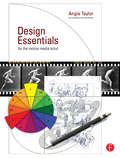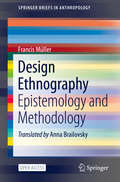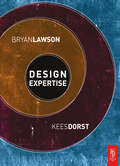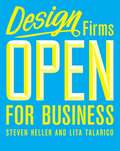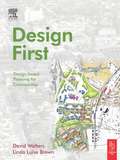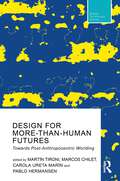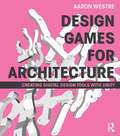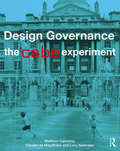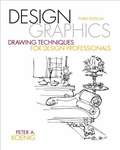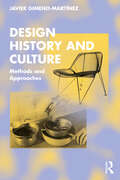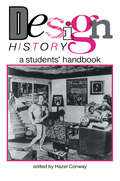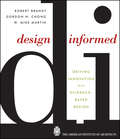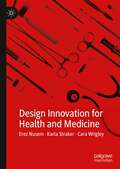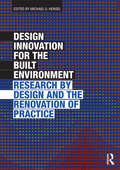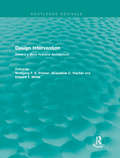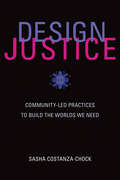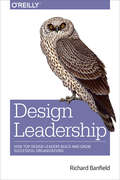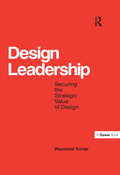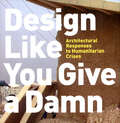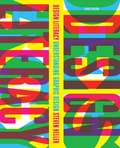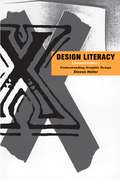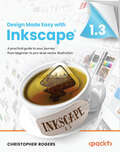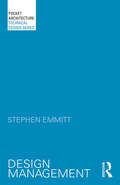- Table View
- List View
Design Essentials for the Motion Media Artist: A Practical Guide to Principles & Techniques
by Angie TaylorMaster the fundamental concepts and techniques of motion media design so you can apply--and occasionally break--the rules to achieve your communication goals. This authoritative guide presents all of the design essentials in an engaging and inspiring way. Each principle is explained with text, illustration and photography where necessary. An accompanying website will contain any necessary digital files for download, updates and links to other resources.
Design Ethnography: Epistemology and Methodology (SpringerBriefs in Anthropology)
by Francis MüllerThis open access book describes methods for research on and research through design. It posits that ethnography is an appropriate method for design research because it constantly orients itself, like design projects, towards social realities. In research processes, designers acquire project-specific knowledge, which happens mostly intuitively in practice. When this knowledge becomes the subject of reflection and explication, it strengthens the discipline of design and makes it more open to interdisciplinary dialogue. Through the use of the ethnographic method in design, this book shows how design researchers can question the certainties of the everyday world, deconstruct reality into singular aesthetic and semantic phenomena, and reconfigure them into new contexts of signification. It shows that design ethnography is a process in which the epistemic and creative elements flow into one another in iterative loops. The goal of design ethnography is not to colonize the discipline of design with a positivist and objectivist scientific ethos, but rather to reinforce and reflect upon the explorative and searching methods that are inherent to it. This innovative book is of interest to design researchers and professionals, including graphic artists, ethnographers, visual anthropologists and others involved with creative arts/media.
Design Expertise
by Kees Dorst Bryan LawsonDesign Expertise explores what it takes to become an expert designer.It examines the perception of expertise in design and asks what knowledge, skills, attributes and experiences are necessary in order to design well. Bryan Lawson and Kees Dorst develop a new model of design expertise and show how design expertise can be developed. This book is designed for all students, teachers, practitioners and researchers in architecture and design. To enable all readers to explore the book in a flexible way, the authors’ words are always found on the left hand page. On the right are diagrams, illustrations and the voices of designers, teachers and students and occasionally others too. 'Design Expertise' provides a provocative new reading on the nature of design and creative thought.
Design Explorations for the Creative Quilter: Easy-to-Follow Lessons for Dynamic Art Quilts
by Katie Pasquini MasopustArt Quilts Made Easy. Bring out your inner artist - explore 10 approaches to designing art quilts with world-renowned teacher Katie Pasquini Masopust. Techniques work for everyone, from beginner to advanced. Creating a gorgeous art quilt is well within your reach when you try Katie Pasquini Masopust's easy methods. Learn 10 different “game plans” for creating a quilt design, then turn your design into a pattern and complete your quilt. With such a variety of techniques to try, you're sure to find the right one for you.
Design Firms Open for Business
by Steven Heller Lita TalaricoWhile many young designers perceive a design studio to be little more than a table and computer, the majority of businesses consider the physical locale and architectural surroundings of a firm to be as important as the work that is produced. Design Firms Open for Business is a firsthand look inside studios and offices, both large and small, from all over the world. The inner workings of more than 40 different-sized and variously focused design establishments are explored, offering keen insights into firms working on everything from two- to three-dimensional projects. Designers reveal their thinking about a broad spectrum of important issues, ranging from the names they selected to the underlying philosophy of their practices to the business models they employ. Profusely illustrated with photos of both specific work and working environments, this book provides a unique blend of analysis and biography rolled into one. Each firm is placed in the spotlight, providing an array of successful models to consider by those who are looking to start their own ventures and by those experienced professionals looking for fresh ideas.
Design First: Design-based Planning For Communities
by Linda Brown David WaltersWell-grounded in the history and theory of Anglo-American urbanism, this illustrated textbook sets out objectives, policies and design principles for planning new communities and redeveloping existing urban neighborhoods. Drawing from their extensive experience, the authors explain how better plans (and consequently better places) can be created by applying the three-dimensional principles of urban design and physical place-making to planning problems.Design First uses case studies from the authors’ own professional projects to demonstrate how theory can be turned into effective practice, using concepts of traditional urban form to resolve contemporary planning and design issues in American communities.The book is aimed at architects, planners, developers, planning commissioners, elected officials and citizens -- and, importantly, students of architecture and planning -- with the objective of reintegrating three-dimensional design firmly back into planning practice.
Design For More-Than-Human Futures: Towards Post-Anthropocentric Worlding (Routledge Research in Design, Technology and Society)
by Martín Tironi Marcos Chilet Carola Ureta Marín Pablo HermansenThis book explores the work of important authors in the search for a transition towards more ethical design focused on more-than-human coexistence. In a time of environmental crises in which the human species threatens its own survival and the highest level of exacerbation of the idea of a future and technological innovation, it is important to discard certain anthropocentric categories in order to situate design beyond the role that it traditionally held in the capitalist world, creating opportunities to create more just and sustainable worlds. This book is an invitation to travel new paths for design framed by ethics of more-than-human coexistence that breaks with the unsustainability installed in the designs that outfit our lives. Questioning the notion of human-centered design is central to this discussion. It is not only a theoretical and methodological concern, but an ethical need to critically rethink the modern, colonialist, and anthropocentric inheritance that resonates in design culture. The authors in this book explore the ideas oriented to form new relations with the more-than-human and with the planet, using design as a form of political enquiry. This book will be of interest to academics and students from the world of design and particularly those involved in emerging branches of the field such as speculative design, critical design, non-anthropocentric design, and design for transition.
Design Games for Architecture: Creating Digital Design Tools with Unity
by Aaron WestreDesign Games for Architecture teaches you how to create playful software tools based on your architectural design processes, whether or not you are familiar with game design technology. The book combines the fun and engaging aspects of video games to ease the sometimes complex process of learning software development. By working through exercises illustrated with screen shots and code, you acquire knowledge about each step required to build useful tools you can use to accomplish design tasks. Steps include analysing design processes to identify their logic, translating that logic into a collection of objects and functions, then encoding the design procedure into a working software tool. Examples presented in the book are design games---tools that a designer “plays” like video games---that span a wide range of design activities. These software tools are built using Unity, free, innovative, and industry-leading software for video game development. Unity speeds up the process of software creation, offers an interface that will be familiar to you, and includes very advanced tools for creating forms, effects, and interactivity. If you are looking to add cutting-edge skills to your repertoire, then Design Games will help you sharpen your design thinking and allow you to specialize in this new territory while you learn more about your own design processes.
Design Governance: The CABE Experiment
by Matthew Carmona Claudio De Magalhaes Lucy NatarajanDesign Governance focuses on how we design the built environment where most of us live, work, and play and the role of government in that process. To do so, it draws on the experience of the Commission for Architecture and the Built Environment (CABE), a decade-long, globally unique experiment in the governance of design. This book theorises design governance as an arm and aspiration of the state; tells the story of CABE, warts and all, and what came before and after; unpacks CABE’s ‘informal’ toolbox: its methods and processes of design governance; and reflects on the effectiveness and legitimacy of design as a tool of modern-day government. The result is a new set of concepts through which to understand the governance of design as a distinct and important sub-field of urban design.
Design Graphics: Drawing Techniques For Design Professionals
by Peter KoenigDesign Graphics: Drawing Techniques for Design Professionals , Third Edition, combines–in a single volume–simple techniques and skills related to sketching, design-development, and the schematic or preliminary phase of design presentation. Emphasizing drawing as a mental as well as physical exercise, the text helps students draw designs on paper faster and easier, showing them how visual communication with clients can provide better, more economical design solutions. Practical, straightforward, and reader-friendly, Design Graphics provides more complete coverage of the basics, making concepts and techniques accessible to students with highly diversified educational and technical backgrounds.
Design History and Culture: Methods and Approaches
by Javier Gimeno-MartínezThis student-friendly text provides a comprehensive exploration of the methods and approaches employed within design scholarship, drawing upon influences from history, art history, anthropology and interdisciplinary studies such as science and technology studies and material culture studies.Drawing connections between these methods and the evolving landscape of design, the book expands design culture beyond traditional outcomes to encompass areas like design for social innovation, digital design, critical design, design anthropology and craftivism. Additionally, the book introduces novel theoretical frameworks to facilitate discussions on contemporary designers’ work, including new materialism, object-oriented ontology and decolonization.This comprehensive overview of methods and approaches will enable students to select the most appropriate methodological tools for their own research. It is an ideal guide for both undergraduate and postgraduate students in design, design culture, design history, design studies and visual culture.
Design History: A Students' Handbook
by Hazel ConwayHazel Conway introduces the student new to the subject to different areas of design history and shows some of the ways in which it can be studied and some of its delights and difficulties. No background knowledge of design history, art or architecture is assumed.
Design Informed
by Martin Robert M. Brandt Gordon Chong W. MikeThe Power of Evidence to Create Design Excellence This practical, accessible book-for design professionals and students alike-is about design excellence and how to achieve it. The authors propose an evidence-based design approach that builds on design ingenuity with the use of research in ways that enhance opportunities to innovate. They show the power of research data to both reveal new design opportunities and convince stakeholders of the value of extraordinary work. A guide for all designers who want to earn their place as their clients' trusted advisor and who aspire to create places of beauty and purpose, the book demonstrates: An approach to applying evidence to design that neither turns designers into scientists nor requires large-firm resources The wide range of types of evidence that can be applicable to design and where to look for it Direct, practical application of the evidence-based design approaches in use today Provides tools to distinguish strong evidence that can improve design decisions from misleading assertions resulting from weak research Benefits of evidence-based design, including improved human and building performance Two featured case studies illustrate the theory and practice of evidence-based design. The work of the authors' 2005-2007 AIA College of Fellows Benjamin Latrobe Research Fellowship provided an empirical foundation for this book, and addresses the use of rigorous research methods to understand relationships between design choices and health outcomes. The California Academy of Sciences, designed by Renzo Piano Building Workshop, Chong Partners Architecture, and Arup, provides transparent evidence that enhances building technology performance in the context of a powerful design expression. In-depth interviews and case studies are clustered around three research categories: modeling, simulation, and data mining; social and behavioral science and the physical and natural sciences; and including cutting-edge use of neuroscience to understand human response to physical environments. The twenty-two featured thought leaders include: William Mitchell, MIT Media Lab; Fred Gage, Salk Institute; Phil Bernstein, Autodesk; Sheila Kennedy, Kennedy & Violich; James Timberlake, KieranTimberlake; William and Chris Sharples, SHoP Architects; Vivian Loftness, Carnegie Mellon University; John Zeisel, Hearthstone; Paco Underhill, Envirosell; Susan Ubbelohde and George Loisos, Loisos+Ubbelohde Architecture-Energy; Chris Luebkeman, Arup; Martin Fischer, Stanford University CIFE; and Kevin Powell, GSA.
Design Innovation for Health and Medicine
by Cara Wrigley Karla Straker Erez NusemDesign Innovation for Health and Medicine offers an innovative approach for solving complex healthcare issues. In this book, three design experts examine a range of case studies to explain how design is used in health and medicine—exploring issues such as diverse patient needs, an ageing population and the impact of globalisation on disease. These case studies, along with high-profile industry projects conducted by the authors over the past decade, inform a novel framework for designing and implementing innovative solutions in this context. The book aims to assist designers, medical engineers, clinicians and researchers to shape the next era of healthcare.
Design Innovation for the Built Environment: Research by Design and the Renovation of Practice
by Michael U. HenselToday architecture and other fields in the built environment face the steep task of answering complex questions pertaining to sustainability, performance, and adaptability. How are these disciplines to accomplish these difficult tasks at such an immense pace? How might architectural practice renovate itself accordingly? Worldwide it is becoming increasingly clear that different modes of research are emerging which are triggered directly by the need to renovate practice. One significant prevailing mode is what has come to be known as ‘research by design’. This book delivers an overview of this pluralistic domain. Bringing together a range of leading architects, architectural theorists, and designers, it outlines the developments in current practice from leading individuals based in the USA, UK, Australia, Japan and Europe. Edited by a recognized expert, this book exposes the undercurrent of research, which is taking place and how this will contribute to the renovation of architectural practice.
Design Intervention: Toward a More Humane Architecture (Routledge Revivals)
by Wolfgang F. E. Preiser Jaqueline C. Vischer Edward T. WhiteDesign Intervention: Toward a More Humane Architecture, first published in 1991, intends to demonstrate that interest in social issues is alive and well in architecture, that there is a small but effective cadre of dedicated professionals who continue to commit themselves to solving social problems, and that architecture is being applied to the alleviation of the social ills of our time. The editors and contributors in this book have all grappled with their own definitions of design innovation, and express in practical and useful ways their ideas for contributing to a better and less needy world through the architecture they describe. This book will be of interest to students of architecture.
Design Justice: Community-Led Practices to Build the Worlds We Need (Information Policy)
by Sasha Costanza-ChockAn exploration of how design might be led by marginalized communities, dismantle structural inequality, and advance collective liberation and ecological survival.What is the relationship between design, power, and social justice? “Design justice” is an approach to design that is led by marginalized communities and that aims expilcitly to challenge, rather than reproduce, structural inequalities. It has emerged from a growing community of designers in various fields who work closely with social movements and community-based organizations around the world.This book explores the theory and practice of design justice, demonstrates how universalist design principles and practices erase certain groups of people—specifically, those who are intersectionally disadvantaged or multiply burdened under the matrix of domination (white supremacist heteropatriarchy, ableism, capitalism, and settler colonialism)—and invites readers to “build a better world, a world where many worlds fit; linked worlds of collective liberation and ecological sustainability.” Along the way, the book documents a multitude of real-world community-led design practices, each grounded in a particular social movement. Design Justice goes beyond recent calls for design for good, user-centered design, and employment diversity in the technology and design professions; it connects design to larger struggles for collective liberation and ecological survival.
Design Language (Interpretive Edition)
by Tim MccreightA simple and elegant primer on the vocabulary used in the art of design.
Design Leadership: How Top Design Leaders Build and Grow Successful Organizations
by Richard BanfieldWhat does it take to be the leader of a design firm or group? We often assume they have all the answers, but in this rapidly evolving industry they’re forced to find their way like the rest of us. So how do good design leaders manage? If you lead a design group, or want to understand the people who do, this insightful book explores behind-the-scenes strategies and tactics from leaders of top design companies throughout North America.Based on scores of interviews he conducted over a two-year period—from small companies to massive corporations like ESPN—author Richard Banfield covers a wide range of topics, including:How design leaders create a healthy company cultureInnovative ways for attracting and nurturing talentCreating productive workspaces, and handling remote employeesStaying on top of demands while making time for themselvesConsistent patterns among vastly different leadership stylesTechniques and approaches for keeping the work pipeline fullMaking strategic and tactical plans for the futureMistakes that design leaders made—and how they bounced back
Design Leadership: Securing the Strategic Value of Design
by Raymond TurnerThe fundamental tenet of this Design Leadership book is that design is a commercial and social imperative and its management and leadership are integral parts of what can make business successful, government effective and society safer and more enjoyable for everyone. The text draws on Raymond Turner’s extensive experience and insights into the effective use of design as a business resource for competitive advantage and social benefit. Raymond brings his experience of working for iconic businesses, projects and consultancies to provide essential, value creating, insights on the interface between design and business. Design Leadership adopts a straightforward approach that will be of great value to those who influence how organisations work - the managers and chief executives of a country’s wealth creating engines. It is also of particular relevance to those with design management and leadership responsibilities as well as students who aim to work in these roles. The ideas at the heart of the book concern all who shape society and have the brief to improve our lives. Raymond Turner’s advice will help all of these readers make design work and so become more effective more quickly.
Design Like You Give A Damn: Architectural Responses To Humanitarian Crises
by Kate Stohr Cameron Sinclair Architecture for Architecture for HumanityThe greatest humanitarian challenge we face today is that of providing shelter. The physical design of our homes, neighborhoods and communities shapes every aspect of our live, yet where architects are most desperately needed, they can least be afforded. Design Like You Give a Damn is a compendium of innovative projects from around the world that demonstrate the power of design to improve lives. It offers a history of the movement toward socially conscious design, and showcases more than 80 contemporary solutions to such urgent needs as basic shelter, healthcare, education and access to clean water, energy and sanitation.
Design Literacy: Understanding Graphic Design
by Steven Heller Rick PoynorAuthor and design expert Steven Heller has revisited and revised the popular classic Design Literacy by revising many of the thoughtful essays from the original and mixing in thirty-two new works. Each essay offers a taste of the aesthetic, political, historical, and personal issues that have engaged designers from the late nineteenth century to the present--from the ubiquitous (the swastika, antiwar posters) to the whimsical (MAD magazine parodies). The essays are organized into eight thematic categories--persuasion, mass media, language, identity, information, iconography, style, and commerce.This revised edition also highlights recent trends in graphic design such as aesthetic changes in typography in the digital age and the nexus between graphic design and wired culture. This is an eclectic look at how, why, and if graphic design influences our ever-evolving, diverse world.
Design Literacy: Understanding Graphic Design
by Steven HellerThis update to the first book to provide explicit case histories of the successful marriage of form and content in graphic design explores more than 125 classic and contemporary works-30 of them brand new-explaining why they are aesthetically significant and how they function as good design. These thought pieces offer a vast taste of the aesthetic, political, historical, and personal issues that move today's global design community and fans.
Design Made Easy with Inkscape: A practical guide to your journey from beginner to pro-level vector illustration
by Christopher RogersDiscover quick and easy ways to make charts, diagrams, illustrations, and UX/UI mockups with end-to-end guidance using hands-on tutorials, tips, and tricksKey FeaturesGet up to speed with vector illustration in no timeExplore hotkey charts and tips, with best practices developed over ten years of using InkscapeLearn the fundamentals of vector illustration and efficiently leverage Inkscape's powerful toolsetBook DescriptionWith the power and versatility of the Inkscape software, making charts, diagrams, illustrations, and UI mockups with infinite resolution becomes enjoyable. If you're looking to get up to speed with vector illustration in no time, this comprehensive guide has got your back! Design Made Easy with Inkscape is easy to follow and teaches you everything you need to know to create graphics that you can use and reuse forever, for free! You'll benefit from the author's industry experience as you go over the basics of vector illustration, discovering tips and tricks for getting professional graphics done fast by leveraging Inkscape's powerful toolset. This book teaches by example, using a great variety of use cases from icons and logos to illustration, web design, and product design. You'll learn about hotkeys and take a best-practices approach developed over ten years of using Inkscape as a design tool in production. What's more, this book also includes links to free graphics resources that you can use in all your projects. Whether you're a new user or a professional, by the end of this book, you'll have full understanding of how to use Inkscape and its myriad of excellent features to make stunning graphics for your projects.What you will learnUnderstand the benefits of vector illustration and the reasons behind choosing Inkscape over other non-free alternativesNavigate the Inkscape setup and workspace to make effective use of the softwareExplore the wide range of tools from Inkscape to create amazing and infinitely scalable graphics quicklyUse real-world scenarios and practice lessons to learn how to create by exampleDiscover tips and tricks to make Inkscape an extension of your creativityConvert photos to vector art and practice with professional design examples as you work with layers, shading, coloring and much moreWho this book is forThis book is for aspiring designers, developers, and anyone who wants to leverage the power of Inkscape for vector illustration. No prior knowledge of graphics applications or vector and raster graphics is required. This book simplifies Inkscape for dummies; all you need to know is how to use a mouse and keyboard.
Design Management (PocketArchitecture)
by Stephen EmmittThis is a design guide for architects, engineers and contractors concerning the principles and application of design management. This book addresses the value that design management and design managers contribute to construction projects. As part of the PocketArchitecture series, Design Management is divided into two parts: Fundamentals and Application. In Part 1, Fundamentals, the chapters address the why, what, how and when questions in a simple and informative style, illustrated with vignettes from design management professionals. In Part 2, case studies from Colombia, Norway and the USA represent unique examples of the application of design management. This book offers a concise overview of design management for postgraduate students and early career design managers.
